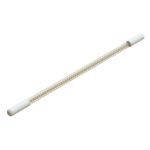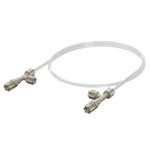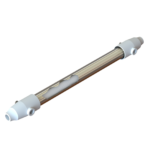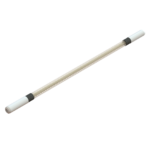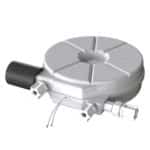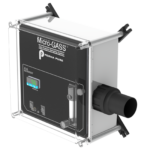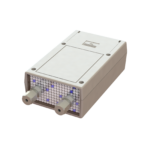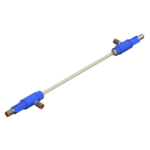Gas Drying
Our dryers are powered by Nafion™ tubing, which selectively removes water vapor from a gas sample. This selectivity for water vapor allows our dryers to remove more moisture than other drying solutions, while maintaining analytes and water-soluble analytes in the gas sample.
-
Improve SNR and reduce gas analyzer maintenance for ambient air monitoring and laboratory analysis.
-
Dry air efficiently for use in applications like ozone generation and IMS spectroscopy.
-
Increase the lifetime of desiccant in applications like gas generation and threat detection.
Click on a dryer solution below to learn more about different sizes and materials available.
Used to simply prevent condensation in a gas stream.
Dries to ambient dew point.
Input Gas:
– Flow rates up to 4 lpm
– Temperatures up to 80 °C
– Pressures up to 80 psig (6 barg)
Requires an enclosure fan if placed inside equipment. In all cases, requires an ambient environment with ventilation.
Gas dryer of choice for environmental and scientific applications with flow rates under 4 lpm
Dries to dew points as low as –40 °C
Input Gas:
– Flow rates up to 4 lpm
– Temperatures up to 100 °C
– Pressures up to 80 psig (6 barg)
Requires a dry purge gas source for operation.
Ideal gas dryer for flow rates up to 40 lpm and applications that demand high drying capacity over a short flow path.
Dries to dew points as low as –40 °C
Input Gas:
– Flow rates up to 40 lpm
– Temperatures up to 100 °C
– Pressures up to 30 psig (2 barg)
Requires a dry purge gas source for operation.
Used to prevent condensation in a high-pressure gas stream.
Dries to ambient dew point.
Input Gas:
– Flow rates up to 4 lpm
– Temperatures up to 50 °C
– Pressures up to 250 psig (17 barg)
Requires an enclosure fan if placed inside equipment. In all cases, requires an ambient environment with ventilation.
Best for drying low-flow rate, humid gases that would otherwise condense at ambient temperature.
Dries to dew points as low as -10 °C
Input Gas:
– Flow rates up to 1.5 lpm
– Temperatures up to 80 °C
– Pressures up to 30 psig (2 barg)
Dryer is heated to accept high temperature and high water-content gases without condensation. Requires power and a dry purge gas source for operation.
Made for gas analysis with electrochemical sensors. Accepts high dew point gases (up to 55 °C) and outputs to ideal relative humidity
Rel. Humidity of output gas between 20-80%.
Input Gas:
– Flow rates 0.5 – 1 lpm
– Temperatures up to 65 °C
– Pressures up to 30 psig (2 barg)
Just requires power.
The only portable dryer that can achieve below-ambient dew points. Typically used for at-the-site sample testing.
Dries to ambient dew point.
Input Gas:
– Flow rates up to 4 lpm
– Temperatures up to 80 °C
– Pressures up to 80 psig (6 barg)
Requires desiccant replacement depending on use.
An MD Series Dryer with user-configurable input/ output purge gas ports for added footprint flexibility.
Dries to dew points as low as –40 °C
Input Gas:
– Flow rates up to 4 lpm
– Temperatures up to 100 °C
– Pressures up to 80 psig (6 barg)
Requires a dry purge gas source for operation.
What is a purge gas source?
Some of our dryers require a purge gas source, such as vacuum or instrument air, connected to the purge ports of the dryer. The purge gas is a gas source that will flow outside the Nafion™ tubing, counter-current to the flow of your gas sample flowing through the Nafion™ tubing. The purge gas needs to have less water vapor than your sample to draw water out of your sample and through the Nafion™ polymer membrane. This is because water vapor removal is driven by the partial pressure differential of water vapor across the membrane.
Why are some of our dryers heated?
Some of our dryers have built-in heating systems to heat gas samples that would otherwise cool to their condensation point (or dew point) if left un-heated. There are several benefits to preventing condensation in the gas stream:
- Water soluble analytes are not lost – water is kept and removed in the vapor-phase.
- Nafion™ tubing performs better; When drying very wet samples that condense at ambient conditions, liquid water can build-up in the Nafion™ polymer membrane – making it less effective at removing water vapor from your gas stream. Heating the Nafion™ tubing prevents liquid water from saturating the membrane.
Can all of our dryers be heated?
With the exception of our desiccant membrane (DM) dryer, all of our dryers without built-in heating systems can be heated.
Can’t find what you need?
Application Support
Contact our Application Support Team with questions about your application.
Custom Solutions
Learn more about working with Perma Pure to meet your gas drying, humidifying, and conditioning needs.

